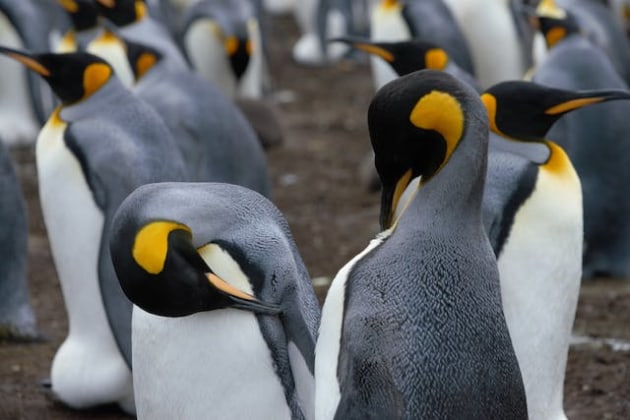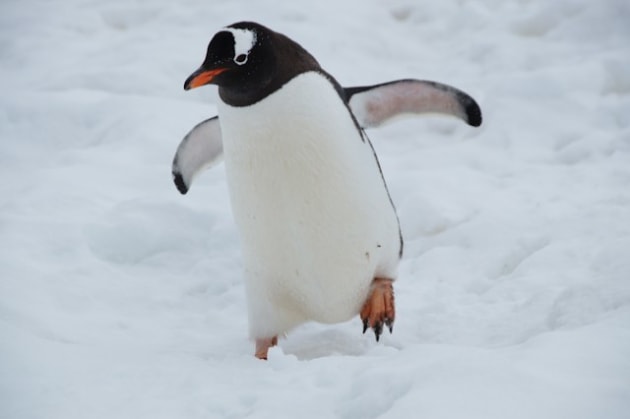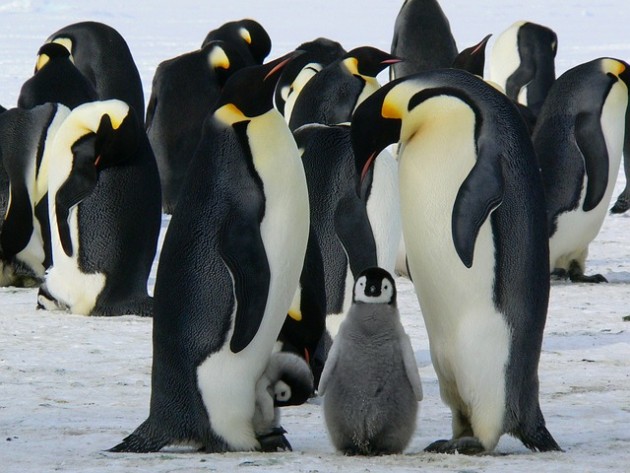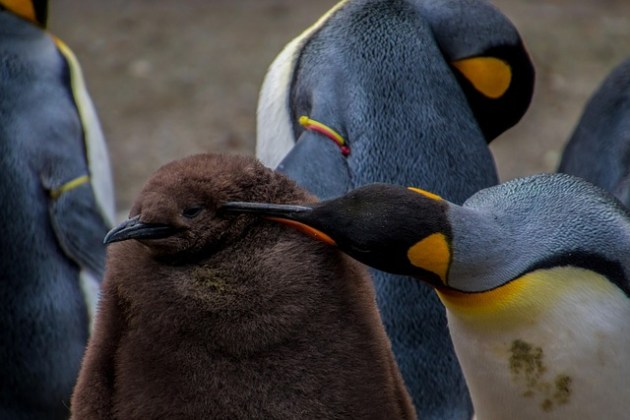



| Scientific name: | Aptenodytes forsteri |
| Lifespan (In the wild): | 15 – 20 years |
| Height (Adult): | 3.6 – 4.3 ft. |
| Mass: | 51 lbs (Male, Adult, After the breeding season) | 51 lbs (Female, Adult, After the breeding season) |
| Speed (In The Water): | 3.7 – 5.6 mph |
| Egg size: | 11.1 to 12.7 cm long |
| Conservation status: | Near Threatened (Population stable) |
While the Emperor Penguin is a majestic bird, it faces numerous challenges on its icy home turf. It is imperative to address the situation and take appropriate actions to ensure the survival of this unique species. In this wiki, we’ll take a look at some fascinating Emperor Penguin Facts for Kids.
The Emperor Penguin, scientifically known as Aptenodytes forsteri, is a remarkable and iconic penguin species that inhabits the icy and inhospitable continent of Antarctica. These penguins are well-known for their unique appearance, incredible adaptability, and fascinating behaviors. They are the largest of all penguin species and have become synonymous with the harsh conditions of the Southern Hemisphere. The Emperor Penguin stands at a remarkable height of 45 inches, making it the tallest among all penguin species. These penguins can weigh up to 88 pounds and live up to two decades in the wild. What sets them apart is their unique ability to swim underwater and fly through the water, making them outstanding aqua-athletes.
Emperor Penguins are instantly recognizable by their striking black and white plumage, which serves as effective camouflage in the surrounding sea and ice. They have a sleek and streamlined body designed for efficient swimming, with wings modified into flippers that enable them to navigate through the water with remarkable agility.
However, these flightless birds are currently facing a significant conservation challenge as they have been classified as "near threatened". The increasing global temperature caused by global warming is having a damaging effect on their breeding grounds, which is further complicated by a decline in their food supply due to overfishing. As a result, these beautiful birds are facing additional stress. Scientists predict that the Emperor Penguin population will face significant challenges over the next three generations due to climate change.

Looking for a fun activity to do with your kids for Penguin Awareness Day? Check out this cool video from theTwinkl YouTube Channeldemonstrating how to draw a penguin. You can use this activity as a fast finisher or implement it just for some added fun and acuteness to your lessons:
Emperor penguins live in Antarctica, where they face extremely cold temperatures. They have developed special ways to adapt to the harsh conditions, such as huddling together to keep warm and protect themselves from the elements. These penguins live in large groups called colonies and are the only penguin species that breed and live on the open ice during the winter months.

Emperor penguins have developed amazing adaptations to survive in their challenging environment. They have a complex defense system consisting of four layers of scale-like feathers that are strategically designed to protect them from the relentless icy winds. Moreover, these resilient creatures can accumulate thick layers of fat, which act as a natural insulation for their bodies against the extreme cold. When they dive into the frigid depths, their feathers flatten, forming a waterproof barrier that shields their skin from the penetrating cold of the surrounding waters.

Emperor penguins have incredible abilities that allow them to navigate the depths of the ocean. Their solid bones prevent barotrauma, which is caused by the intense underwater pressure that is up to 40 times more than the surface. This enables them to dive deeper than most other species.
During their deep-sea excursions, Emperor penguins reduce their heart rate to an astonishingly low 15-20 beats per minute. This is a remarkable physiological feat that helps them conserve oxygen, allowing them to stay underwater for extended periods. As a strategic response, non-essential organs temporarily shut down, enabling these incredible birds to optimize their oxygen consumption for prolonged dives.

Emperor penguins are equipped with a specialized toolkit of features that contribute to their survival in the unforgiving Antarctic environment. Smooth stomachs enable them to effortlessly slide on the ice, a seemingly playful yet efficient method of traversing their frozen domain. Strong claws provide essential grip as they shuffle along the icy terrain, showcasing their adaptability to the challenges of their surroundings.
The small bills of Emperor penguins play a vital role in heat conservation, a crucial aspect of their survival in the extreme cold. This evolutionary trait minimizes heat loss, contributing to the overall efficiency of these remarkable creatures. In the aquatic realm, powerful flippers propel them swiftly through the water, showcasing their agility and effectiveness as adept swimmers.
Emperor penguins primarily eat fish, crustaceans, and cephalopods. They mainly feed on Antarctic silverfish and also eat squid and Antarctic krill.

Every winter season, the Emperor penguins in Antarctica travel up to 50 miles to reach safe breeding grounds. The male penguins lead the way in this annual pilgrimage, to find a mate for the breeding season. They use displays and courtship calls to attract a suitable partner.
Emperor penguins are known for their monogamous nature, committing to a single mate per breeding season. The challenges of parenthood begin before the eggs are laid, as both male and female penguins lose weight and dedicate themselves to the demanding tasks of raising hatchlings and incubating their eggs. During the incubation phase, which lasts for over two months, male Emperor penguins endure the harsh Antarctic conditions, abstaining from eating, resulting in a weight loss of around 12 kilograms.
These regal birds of the icy Antarctica landscape have an impressive lifespan that reflects their ability to adapt to the harsh conditions of their habitat. On average, an emperor penguin can live for around 15 to 20 years, but some individuals have been known to live even longer.
The factors that influence the lifespan of emperor penguins are diverse. They range from environmental conditions to predation risks and overall health. Let’s explore some of these aspects so we can gain a better understanding of the remarkable life expectancy of these iconic birds.
The emperor penguin's reproductive cycle is unique in that they breed during the harsh Antarctic winter, showcasing their resilience and adaptability, which play a crucial role in shaping their lifespan.
Emperor penguins undertake a difficult journey to reach their breeding grounds, where they participate in elaborate courtship ceremonies. Mating occurs during the winter season, and the female emperor penguin lays one egg. The male emperor penguin then takes on the task of incubating the egg by carefully balancing it on his feet and keeping it nestled against a warm brood pouch.

After hatching, the chicks depend on their parents for sustenance and protection. Both parents share the responsibilities of feeding and safeguarding the chicks. This cooperative parenting ensures the survival of the offspring in the challenging Antarctic environment.
Here's a Brief Overview of the Emperor Penguin's Natural Life Cycle:
Egg-laying
In May, female penguins lay one egg and leave it with the male penguin. He takes care of the egg while the female returns to the ocean. This process shows the commitment and dedication of penguin parents in ensuring successful reproduction.
Incubation
Male penguins take on the task of keeping the egg warm during cold winter months. They do this by nestling the egg in a brood pouch on top of their feet. They ensure the egg remains safe and warm. When the female penguin returns from hunting and fishing trips in July, she feeds the chick by regurgitating food.
Molting

An interesting transformation takes place during the molting process as chicks shed their soft, fluffy down feathers. This makes way for the growth of sleek, waterproof plumage. This is a fascinating natural phenomenon that occurs in various bird species.
Fledging
In December, as the sea ice starts to melt, the young penguins say goodbye to their home and begin their journey toward the sea. They walk across the icy terrain, making their way towards the ocean.
Breeding
Finally, in April, after about five years of maturing, the young penguins return to land. They seek a partner to start a new chapter of their lives, bringing their journey full circle.

Ready to test your students' knowledge of the fascinating world of penguins? At Twinkl, we have some incredible resources that are both educational and fun. Let’s take a closer look at three activities that offer penguin facts for kids:
Let's start with our Life-size Emperor Penguin Cutout. This resource is simply fantastic as it allows you to bring the charm of these majestic birds right into your classroom with (as the title suggests) a life-size Emperor Penguin cutout! All you have to do is print out the pieces, tape them together, and voila, you've got a life-size penguin display that will captivate your students.
Next up, we have the Penguins PowerPoint and Quiz. This dynamic duo is designed to introduce students to the captivating world of penguins and their habitats. The PowerPoint is a multimedia-rich presentation that covers everything from where penguins live to what they eat and how they raise their adorable chicks.
Our First Grade Penguins Reading Passage Comprehension Activity is an outstanding resource for introducing young minds to the world of penguins. It skillfully combines informative content with interactive elements, ensuring an engaging learning experience.
The Label the Penguin Activity is a versatile and engaging resource designed to help students in kindergarten through second grade explore the anatomy of penguins. This hands-on activity goes beyond traditional teaching methods, offering a dynamic and interactive way for children to learn about the different parts of these fascinating creatures.
Last but certainly not least is our Kindergarten Penguins Reading Passage Comprehension Activity. Reading is a fundamental skill, and we understand the importance of nurturing it from an early age. That's why our dedicated team at Twinkl has crafted this engaging reading comprehension activity specifically for kindergarteners.
These resources offer a comprehensive and engaging approach to teaching kids about penguins. From life-size cutouts to multimedia-rich presentations and interactive reading activities, we've got you covered. We hope you enjoyed our Emperor Penguin Facts for Kids wiki. Ready to explore more? Head over to our site for more educational content. And don’t forget to register for a Twinkl account before you leave to access even more resources to make learning an adventure for your students!